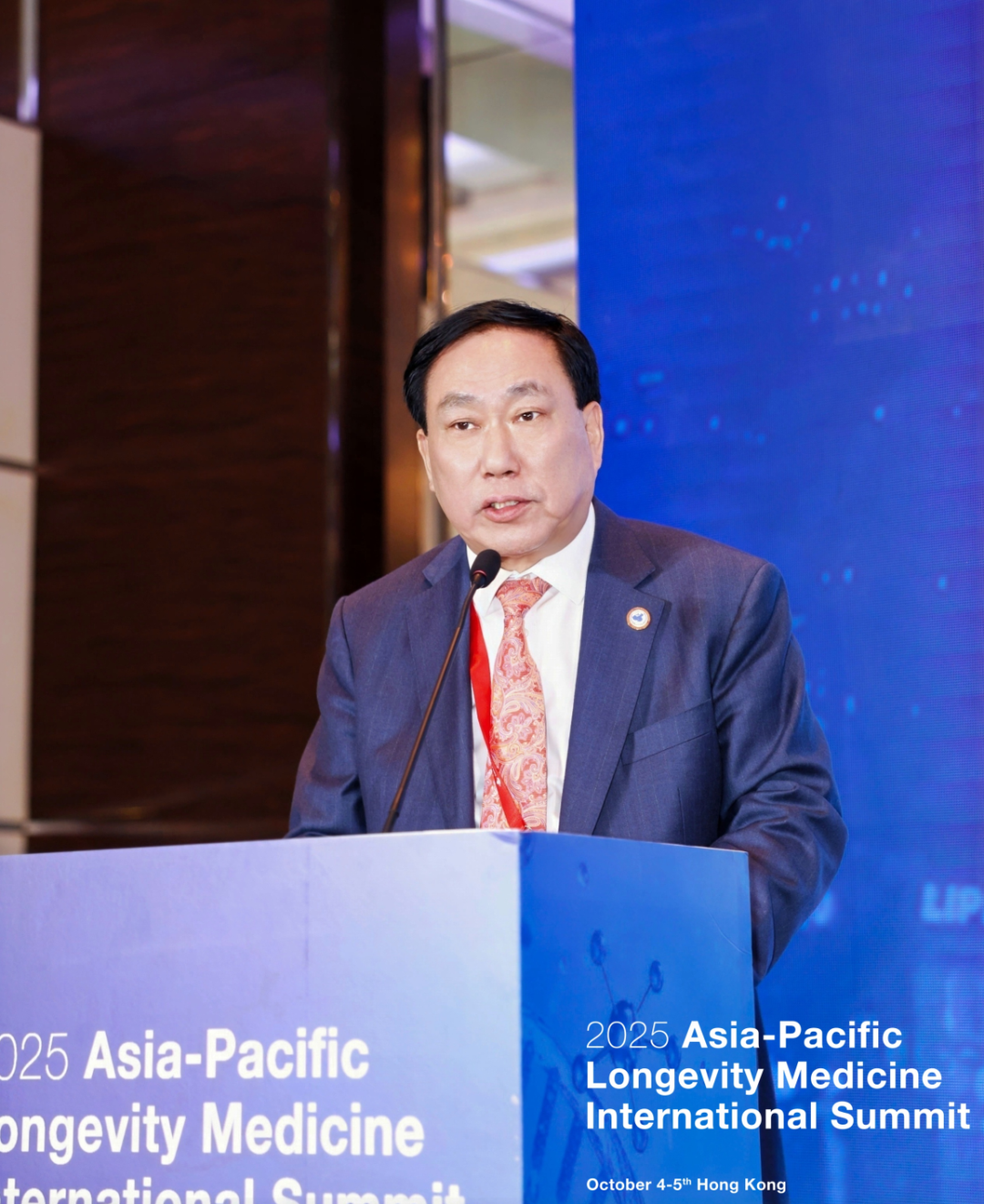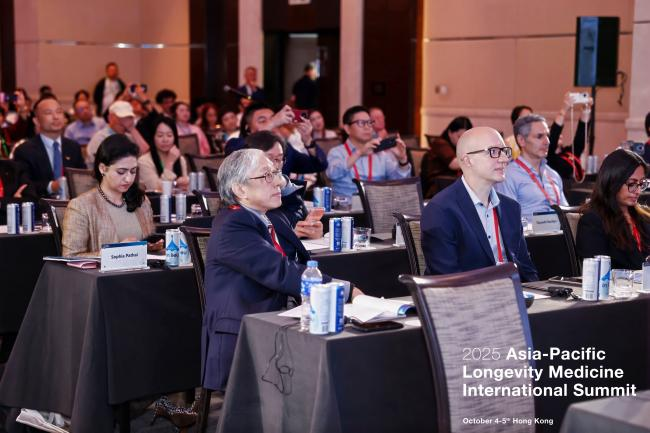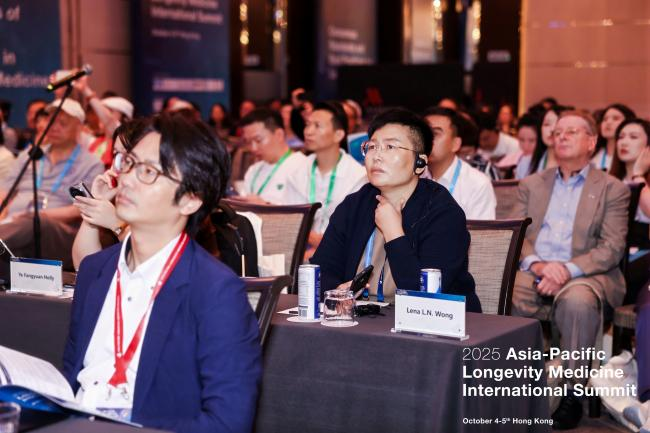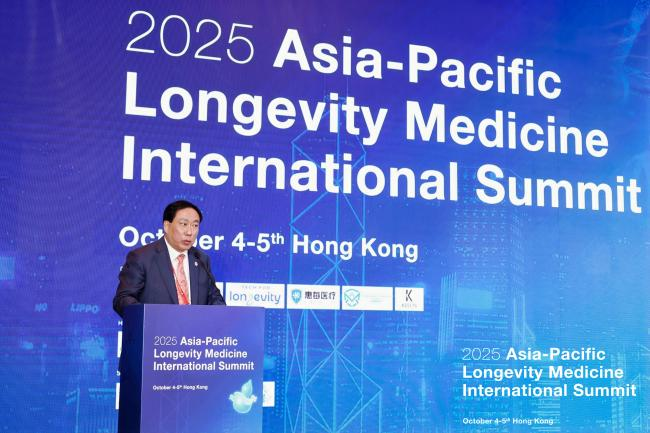编者按
在全球老龄化加速推进、“长寿时代”已然到来的当下,2025亚太长寿医学国际峰会于香港隆重召开,为亚太地区乃至全球长寿医学领域的交流与合作搭建了重要平台。中国非公立医疗机构协会常务副会长兼秘书长、法定代表人郝德明会长在峰会上的致辞,以深邃的行业洞察与务实的发展思路,为我们勾勒出中国长寿医学的发展现状与未来方向。
致辞中,郝会长既直面中国老龄化带来的健康挑战,也清晰梳理了政策支持下中国长寿医学的学科特色与非公立医疗机构的独特优势,更坦诚指出行业发展中存在的标准化、技术应用、国际合作等短板。尤为重要的是,他从标准建设、模式创新、国际合作、生态构建四个维度提出的发展建议,兼具行业高度与实践可行性,为推动中国长寿医学高质量发展、促进亚太地区长寿医学领域协同共进提供了清晰路径。
今日,我们刊发郝德明会长的这篇致辞,旨在让更多行业同仁、社会各界深入了解中国长寿医学的发展态势与机遇,激发思考、凝聚共识、汇聚力量,共同投身于应对老龄化挑战、守护全民健康长寿的事业中,期待以思想的碰撞激发更多创新实践,让长寿医学的成果惠及更多民众。
中国非公医协郝德明会长
在2025亚太长寿医学国际峰会的致辞
(2025年10月4日·香港)
尊敬的各位专家、各位同仁:
Distinguished Experts, Dear Colleagues,
大家好!
Good morning!
我非常荣幸在2025亚太长寿医学国际峰会与各位相聚。当“活得更健康,活得更长久,拥抱更优质生活方式”的峰会主题响彻香江,我们既看到了全球应对老龄化挑战的共同追求,更感受到了亚太地区在长寿医学领域携手前行的坚定决心。在此,我谨代表协会,向峰会的召开致以热烈祝贺!
It is a great honor to join you all at the 2025 Asia-Pacific Longevity Medicine International Summit. As the summit’s theme, “, Live Longer,Live Healthier, Embrace the Better Lifestyle, ” resonates across Hong Kong, we not only witness a shared global pursuit to address the challenges of aging but also feel the firm determination of the Asia-Pacific region to advance hand in hand in the field of longevity medicine. On behalf of the association, I extend my warmest congratulations on the opening of this summit!

全球预期寿命的持续延长,既彰显了医学进步的成就,也催生了对长寿医学的迫切需求。亚太地区作为人口最稠密的区域,在长寿研究与抗衰技术应用上具有天然优势——中国香港、日本、新加坡等国家和地区凭借完善的医疗体系与先进的康养理念,已成为全球长寿领域的标杆。而中国大陆正经历着深刻的人口结构转型,截至2024年底,60岁及以上人口已超过3.1亿,占全国人口22%,人均预期寿命达到78.6岁的同时,老龄化带来的健康挑战也日益凸显。这种“长寿时代”的到来,既考验着医疗体系的应对能力,更孕育着医学发展的历史机遇。
The continuous increase in global life expectancy highlights the achievements of medical progress while also generating an urgent demand for longevity medicine. As the most densely populated region, the Asia-Pacific area possesses inherent advantages in longevity research and the application of anti-aging technologies. Places like Hong Kong, Japan, and Singapore, with their well-established healthcare systems and advanced wellness concepts, have become benchmarks in the global longevity field. Meanwhile, mainland China is undergoing profound demographic transformations. By the end of 2024, the population aged 60 and above had exceeded 310 million, accounting for 22% of the national population. While the average life expectancy has reached 78.6 years, health challenges associated with aging are becoming increasingly prominent. The advent of this “longevity era” not only tests the resilience of healthcare systems but also heralds historic opportunities for medical development.
应对挑战、把握机遇,离不开政策的引领。中国政府始终将老年健康置于重要战略位置,《“健康中国2030”规划纲要》明确将老龄化应对作为重点任务,提出到2030年健康产业规模向发达国家看齐的目标。今年4月,国家卫生健康委印发《老年医学科建设与管理指南(2025年版)》,从科室设置、人员配备、服务模式等维度作出刚性规范,要求有条件的二级及以上综合医院必须开设老年医学科,明确三级医院老年医学科床位不少于20张,每张病床需配备0.3名医师和0.6名护士,并鼓励配置康复治疗师、营养师等专业人员。这一系列政策既夯实了长寿医学的基本医疗根基,也为非基本医疗服务创新预留了发展空间,彰显了中国推动长寿医学高质量发展的坚定决心。
Addressing challenges and seizing opportunities requires policy guidance. The Chinese government has always placed elderly health in a strategic position of importance. The “Healthy China 2030” blueprint explicitly identifies aging response as a key task, aiming to align the scale of the health industry with that of developed countries by 2030. In April of this year, the National Health Commission issued the “Guidelines for the Construction and Management of Geriatrics Departments ” which set mandatory standards in areas such as department setup, staffing, and service models. It requires qualified secondary and above general hospitals to establish geriatrics departments, stipulating that tertiary hospitals must have at least 20beds in their geriatrics departments, with 0.3 physicians and 0.6 nurses per bed, while also encouraging the inclusion of rehabilitation therapists, nutritionists, and other professionals. These policies not only strengthen the foundational medical infrastructure for longevity medicine but also create room for innovation in non-essential medical services, demonstrating China ’ s firm commitment to advancing high-quality development in longevity medicine.

在这样的政策指引下,中国长寿医学已形成鲜明的学科特色——作为基本医疗与非基本医疗的交叉领域,它既涵盖老年综合征诊疗、共病管理等基本医疗服务,又包括健康维护、功能提升、生活品质改善等个性化非基本医疗服务。这种双重属性,恰好与中国近50万家非公立医疗机构的发展定位高度契合。从贡献近30%诊疗量的行业服务体量来看,非公立医疗机构早已成为医疗服务体系的重要组成部分,而其运营机制灵活、服务创新活跃的特点,更使其在长寿医学交叉领域具有天然优势。
Under such policy guidance, longevity medicine in China has developed distinct disciplinary characteristics. As an interdisciplinary field spanning essential and non-essential medical services, it encompasses both basic medical services, such as the diagnosis and treatment of geriatric syndromes and the management of comorbidities, and personalized non-essential medical services, including health maintenance, functional enhancement, and quality-of-lifeimprovement. This dual nature aligns closely with the development positioning of nearly 500,000 non-public medical institutions in China. With non-public medical institutions already contributing nearly 30% of outpatient and inpatient services, they have become a vital component of the healthcare system. Their flexible mechanisms and innovative dynamism give them a natural advantage in the interdisciplinary field of longevity medicine.
当前,中国非公立医疗机构已在长寿医学领域探索出多条有效路径。近年来,一大批康养医院、医养医院、康复医院和老年护理医院等新兴健康产业,正在如雨后春笋般涌现。在基本医疗层面,许多医疗机构主动对接政策要求,通过改造空闲床位、组建多学科团队,规范开展老年综合评估与共病诊疗,仅需轻量改造即可将内科、康复科病区转型为医养结合单元,快速提升老年医疗服务供给能力。在非基本医疗层面,医疗机构正积极拓展健康管理、康复护理、家庭医生、居家养老和心理支持等服务,通过“医院+护理院”模式构建康养服务链,或通过模块化嵌入养老场景提供精准服务,形成了与公立医疗的差异化互补。更有医疗机构借力“互联网+”技术,通过远程监测、上门服务等方式,将专业服务延伸至社区与家庭,有效满足了老年人多元化健康需求。
Currently, non-public medical institutions in China have explored multiple effective pathways in longevity medicine. At the level of essential medical services, many institutions proactively align with policy requirements by repurposing idle beds and forming multidisciplinary teams to standardize comprehensive geriatricassessments and comorbidity management. With minimal adjustments, they can transform internal medicine and rehabilitation wards into integrated medical and elderly care units, rapidly enhancing the supply of geriatric medical services. In the realm of non-essential medical services, institutions are actively expanding into areas such as health management, rehabilitation care, and psychological support. By adopting models like “hospital + nursing home,” they create integrated wellness service chains or provide targeted services through modular integration into elderly care settings, forming a complementary relationship with public healthcare. Some institutions are leveraging “internet plus” technologies to extend professional services to communities and households through remote monitoring and home visits, effectively meeting the diverse health needs of the elderly.

但我们也清醒认识到,行业发展仍面临诸多挑战:部分医疗机构服务标准化不足,多学科协作机制尚未健全;技术应用水平参差不齐,AI驱动的个性化解决方案普及率较低;国际交流合作不够深入,未能充分借鉴亚太地区先进经验。这些问题既制约着非公立医疗机构的服务能力,也影响着中国长寿医学的整体发展水平。
However, we are also acutely aware that the industry still faces numerous challenges. Some medical institutions lack standardized services, and multidisciplinary collaboration mechanisms are not yetfully established. The application of technology is uneven, with AI-driven personalized solutions remaining underutilized. International exchanges and cooperation are insufficient, hindering the full adoption of advanced experiences from the Asia-Pacific region. These issues constrain the service capabilities of non-public medical institutions and impact the overall development of longevity medicine in China.
长寿医学的可持续发展,离不开标准化与规范化,中国非公医协(CNMIA)积极推动行业标准化建设,日前,由惠每健康上海科技公司发起的《长寿医学医师专业能力规范化培训体系》已在本会正式获得国家级行业团体标准立项,这一举措填补了国内空白,同时,双方基于梅奥诊所(Mayo Clinic)资源的国际会诊服务合作项目也正在计划推进。在此,针对长寿医学,我愿从国家行业服务与行业管理两个维度提出四点建议,与各位同仁共勉:
The sustainable development of longevity medicine relies on standardization and regulation. The Chinese Non-Government Medical Institutions Association (CNMIA) is actively promoting industry standardization. Recently, the “Standardized Training System for Professional Competence of Longevity Medicine Physicians,” initiated by Huimei Health Shanghai Technology Company, was officially approved as a national industry group standard by our association. This initiative fills a domestic gap. Additionally, acollaborative project for international consultation services based on Mayo Clinic resources is in the planning stages. Regarding longevity medicine, I would like to propose four recommendations from the perspectives of national industry services and industry management for our colleagues to consider:
第一,以标准建设为核心,筑牢交叉领域服务根基。
First, prioritize standardization to strengthen the foundation of interdisciplinary services.
针对长寿医学交叉学科特点,我们需加快构建双重服务标准体系。即在基本医疗领域,严格对标《老年医学科建设与管理指南》,规范老年综合评估、共病处理、安全用药等服务流程,确保与公立医疗体系标准统一、质量同质。而在非基本医疗领域,协会将牵头制定健康管理、康复护理等团体标准,明确服务内容、技术规范和质量评价体系,通过标准引领实现服务升级。同时建立分级评价机制,推动医疗机构从“规模扩张”向“质量提升”转型。
Given the interdisciplinary nature of longevity medicine, we must accelerate the establishment of a dual service standard system. In the realm of essential medical services, we must strictly align with the “Guidelines for the Construction and Management of Geriatrics Departments,” standardizing processes such as comprehensive geriatric assessments, comorbidity management, and safe medication use to ensure uniformity with public healthcare standards and quality.In non-essential medical services, the association will take the lead in developing group standards for health management, rehabilitation care, and other areas, clarifying service content, technical specifications, and quality evaluation systems. Through standardization, we aim to achieve service upgrades and establish a tiered evaluation mechanism to transition medical institutions from “scale expansion” to “quality improvement.”
第二,以模式创新为突破,激活市场主体活力。
Second, foster innovation in models to invigorate market entities。
鼓励非公立医疗机构聚焦三大方向创新发展:一是深化“医养融合”模式,通过医院与养老机构签约合作、共建联合体等方式,实现医疗资源与养老服务精准对接;二是发展“数字+长寿医疗”模式,积极应用AI问诊、远程监测等技术,构建覆盖预防、诊疗、康复的全周期服务体系,呼应数字健康服务5000亿元市场规模的发展机遇;三是打造“精准化特色服务”模式,在老年康复、营养支持、心理疗愈等细分领域形成专长,满足个性化健康需求。
Non-government medical institutions are encouraged to innovate in three key directions: First, deepen the “integration of medical and elderly care” model by facilitating partnerships between hospitals and elderly care institutions, establishing joint entities, and ensuring precise alignment of medical resources with elderly care services.Second, develop the “digital + longevity medicine” model by actively adopting technologies such as AI consultations and remote monitoring to build a full-cycle service system covering prevention, diagnosis, treatment, and rehabilitation. This aligns with the developmental opportunities presented by the digital health service market, which is projected to reach RMB 500 billion. Third, create “personalized specialty services” by developing expertise in areas such as geriatric rehabilitation, nutritional support, and psychological therapy to meet individualized health needs.
第三,以国际合作为纽带,汇聚亚太发展合力。
Third, strengthen international cooperation to pool resources for Asia-Pacific development.
建议建立三大合作机制:一是学术交流机制,与日本、新加坡等地区的研究机构共建联合实验室,聚焦慢病管理、精准医疗等重点领域开展联合研究;二是技术共享机制,借鉴中国香港在长寿科技转化、诊所运营等方面的先进经验,搭建技术转移平台;三是人才培养机制,开展跨境培训与学术访问,联合培养既懂基本医疗又通非基本服务的复合型人才,为行业发展注入活力。
I propose establishing three cooperation mechanisms: First, an academic exchange mechanism to collaborate with research institutions in Japan, Singapore, and other regions, establishing joint laboratories and conducting research in key areas such as chronicdisease management and
precision medicine. Second, a technology-sharing mechanism to learn from advanced experiences in longevity technology transfermation and clinic operations in places like Hong Kong, and to build technology transfer platforms. Third, a talent development mechanism to facilitate cross-border training and academic exchanges, cultivating professionals proficient in both essential and non-essential medical services to inject vitality into the industry.
第四,以生态构建为支撑,优化行业发展环境。
Fourth, support ecosystem development to optimize the industry environment.
一方面,推动政策协同,建议政府部门完善医保支付与非基本医疗服务衔接机制,为交叉领域服务创新提供保险政策保障;另一方面,强化行业自律,建立诚信评价体系与不良行为惩戒机制,维护市场秩序;同时搭建行业服务平台,提供政策解读、技术推广、国际对接等服务,助力机构高质量发展。
On one hand, we should promote policy coordination by encouraging government departments to improve the linkage between medical insurance payments and non-essential medical services, providing insurance policy support for innovation in interdisciplinary services. On the other hand, we should strengthen industry self-regulation by establishing integrity evaluation systems and mechanisms forpenalizing misconduct to maintain market order. Simultaneously, we should build industry service platforms to offer policy interpretation, technology promotion, international collaboration, and other services to support high-quality development of institutions.

各位同仁,作为经国务院批准成立的中国非公立医疗机构协会,是全国唯一的非公立医疗机构的行业管理组织,针对有近50万家医疗机构,2.7万家医院的行业管理,我们已建立92个不同专业的全国性分支机构,推进成立了237家地方行业协会,评估设立了362个国际医疗旅游示范基地和47个中日医疗合作基地。我们有责任有义务也有能力致力于推动行业规范发展,正如我们所倡导的,要做技术创新的“破壁者”、分级诊疗的“粘合剂”、健康公平的“守护者”。在长寿医学领域,我们将继续发挥国家级行业组织作用,既要推动行业内部的标准统一与能力提升,更要促进中国与亚太各国的深度合作。
Dear colleagues, as an association approved by the State Council, the Chinese Non-Government Medical Institutions Association has the responsibility and obligation to promote the standardized development of the industry. As we advocate, we must act as “breakers of barriers” in technological innovation, “adhesives” in tiered healthcare, and “guardians” of health equity. In the field of longevity medicine, we will continue to serve as a bridge, not only promoting standardization and capability enhancement within the industry but also fostering deeper cooperation between China and other Asia-Pacific countries.
中国香港作为连接内地与全球的桥梁,为我们搭建了得天独厚的合作平台。相信通过本次峰会,我们能够汇聚亚太智慧,共享先进经验,在长寿医学技术创新、政策协同、服务优化等方面达成更多共识。让我们以此次峰会为起点,携手推进国际合作,让先进的长寿医学技术惠及更多民众,共同应对老龄化挑战,为实现“全民健康、幸福长寿”的美好愿景贡献力量!
Hong Kong, as a bridge connecting mainland China and the world, provides a unique platform for collaboration. I believe this summit will enable us to pool the wisdom of the Asia-Pacific region, share advanced experiences, and reach greater consensus on technological innovation, policy coordination, and service optimization in longevity
medicine. Let us take this summit as a starting point to advance international cooperation, ensure that advanced longevity medicine technologies benefit more people, jointly address the challenges of aging, and contribute to the vision of “health and happiness for all in longevity”!
最后,预祝本次峰会圆满成功!祝各位同仁身体健康、工作顺利!
Finally, I wish this summit a complete success! I wish you all good health and great success in your work!








